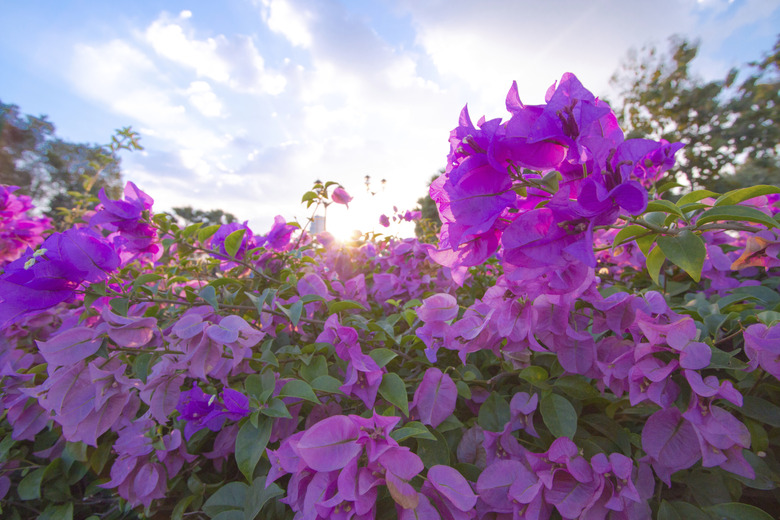Does Bougainvillea Grow Fast?
Bougainvillea (Bougainvillea spp.) are fast growers, a botanical term that for vines means they can grow more than 36 inches year. Bougainvilleas will only achieve this rapid growing rate under their optimal preferences for weather and growing conditions. By comparison, a fast-growing fern may only grow 6 inches a year, and a fast-growing tree 24 inches or more.
Bougainvillea Basics
Bougainvillea Basics
Bougainvillea is a subtropical and tropical woody evergreen vine. It spreads by stems in the form of slender arching canes studded with curved thorns. The canes turn from mid-green to dull green-brown as they mature. Their large heart-shaped leaves have hairs on the bottom and rippled edges. Their tubular flowers, resting in pink or purple bracts, are typically yellow or white.
Nurseries typically carry two species: Bougainvillea spectabilis, commonly called great bougainvillea, and Bougainvillea glabra, commonly called paper bougainvillea because of the bracts on its flowers.
Both species grow in U.S. Department of Agriculture plant hardiness zones 9 through 11, their vines spreading up to 20 feet.
Great bougainvillea can only tolerate low temperatures of 64 to 68 degrees Fahrenheit, but paper bougainvillea can tolerate temperatures as low as 58 to 64 degrees F.
You may also find named cultivars of the hybrid Bouginvillea x buttiana, sometimes listed as Bougainvillea x Bougainvillea peruviana, which spread up to 40 feet, also growing in USDA zones 9 through 11.
Conditions for Fast Growth
Conditions for Fast Growth
Bougainvilleas grow fast in bright sunlight and slower in the shade and areas with low light. They like rich, well-drained soil with a pH of 5.5 to 6.0. They do not grow well in soil that is constantly wet.
Although they can tolerate temperatures over 100 degrees F and dry weather, Bougainvilleas need 25 inches of rain a year for fastest growth. They grow best in temperatures from 75 to 95 degrees F during the day and a minimum of 65degrees F at night.
Bougainvilleas endure the salt of coastal areas and tolerate wind. They also grow best at elevations from 10 to 2,500 hundred feet.
Fertilizer and Growth
Fertilizer and Growth
Over-fertilizing bougainvilleas, especially with nitrogen, can lead to greater growth of the vines but fewer flowers. Bougainvilleas are typically planted in the spring or summer. Do not fertilize then. Wait a month to six weeks, then scatter a 1 teaspoon of slow release 12-4-6 fertilizer around the base of the plant and water it well.
Early the next spring when the bougainvillea is established, fertilize it twice, once in early spring and again in midsummer. Each time apply 6 ounces of 12-4-6 slow-release fertilizer per 25 square feet, and water well.
Pruning to Control Growth
Pruning to Control Growth
*Since bougainvillea shoots grow vigorously, prune regularly to direct the growth and shape of the plant.
To increase the growth at the top, prune suckers from the base of the plant.
To reduce the size of bougainvilleas, prune spindly and twiggy growth and cut shoots back by roughly one-third. If you prune them too much, you will reduce their display of flowers.
Prune bougainvilleas after the start of a rainy season if you have one or after it produces flowers abundantly. Bougainvilleas typically yield the most blooms from early autumn through early spring. Pruning in late summer or early autumn will cut the number of flowers in this blooming season.
To prevent the spread of disease, disinfect pruning tools by dipping them in a solution of 1 part household bleach to 3 parts of water then rinsing with water and allowing to air dry.
References
- University of Florida IFAS Extension: Bougainvillea – A Robust and Spectacular Climbing Vine
- University of Hawaii Extension: Bougainvillea
- University of Florida Extension: Warm Climate Production Guidelines for Bougainvillea
- Alabama Cooperative Extension Service: Vines for Alabama Landscapes
- University of Florida Extension: Bougainvillea Spp.
- Texas A&M University Extension: Growing Bougainvilleas
- Floridata: Bougainvillea Spp.
- Nature Hills Nursery: General FAQs
- Blue Planet Biomes: Bougainvillea
- National Gardening Association: Beautiful Bougainvillea
